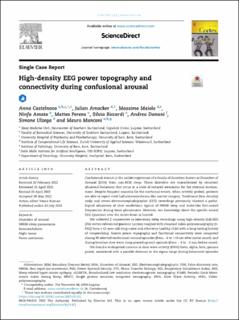Please use this identifier to cite or link to this item:
https://doi.org/10.21256/zhaw-25625| Publication type: | Article in scientific journal |
| Type of review: | Peer review (publication) |
| Title: | High-density EEG power topography and connectivity during confusional arousal |
| Authors: | Castelnovo, Anna Amacker, Julian Maiolo, Massimo Amato, Ninfa Pereno, Matteo Riccardi, Silvia Danani, Andrea Ulzega, Simone Manconi, Mauro |
| et. al: | No |
| DOI: | 10.1016/j.cortex.2022.05.021 10.21256/zhaw-25625 |
| Published in: | Cortex |
| Issue: | 155 |
| Page(s): | 62 |
| Pages to: | 74 |
| Issue Date: | 22-Jul-2022 |
| Publisher / Ed. Institution: | Elsevier |
| ISSN: | 0010-9452 1973-8102 |
| Language: | English |
| Subjects: | Disorder of arousal; NREM-sleep parasomnia; Brain connectivity; Somnambulism; Night terror; Pavor nocturnus |
| Subject (DDC): | 616.8: Neurology, diseases of nervous system |
| Abstract: | Confusional arousal is the milder expression of a family of disorders known as Disorders of Arousal (DOA) from non-REM sleep. These disorders are characterized by recurrent abnormal behaviors that occur in a state of reduced awareness for the external environment. Despite frequent amnesia for the nocturnal events, when actively probed, patients are able to report vivid hallucinatory/dream-like mental imagery. Traditional (low-density) scalp and stereo-electroencephalographic (EEG) recordings previously showed a pathological admixture of slow oscillations typical of NREM sleep and wake-like fast-mixed frequencies during these phenomena. However, our knowledge about the specific neural EEG dynamics over the entire brain is limited. We collected 2 consecutive in-laboratory sleep recordings using high-density (hd)-EEG (256 vertex-referenced geodesic system) coupled with standard video-polysomnography (v-PSG) from a 12-year-old drug-naïve and otherwise healthy child with a long-lasting history of sleepwalking. Source power topography and functional connectivity were computed during 20 selected confusional arousal episodes (from -6 to +18 sec after motor onset), and during baseline slow wave sleep preceding each episode (from - 3 to -2 min before onset). We found a widespread increase in slow wave activity (SWA) theta, alpha, beta, gamma power, associated with a parallel decrease in the sigma range during behavioral episodes compared to baseline sleep. Bilateral Broadman area 7 and right Broadman areas 39 and 40 were relatively spared by the massive increase in SWA power. Functional SWA connectivity analysis revealed a drastic increase in the number and complexity of connections from baseline sleep to full-blown episodes, that mainly involved an increased out-flow from bilateral fronto-medial prefrontal cortex and left temporal lobe to other cortical regions. These effects could be appreciated in the 6 sec window preceding behavioral onset. Overall, our results support the idea that DOA are the expression of peculiar brain states, compatible with a partial re-emergence of consciousness. |
| URI: | https://digitalcollection.zhaw.ch/handle/11475/25625 |
| Fulltext version: | Published version |
| License (according to publishing contract): | CC BY 4.0: Attribution 4.0 International |
| Departement: | Life Sciences and Facility Management |
| Organisational Unit: | Institute of Computational Life Sciences (ICLS) |
| Published as part of the ZHAW project: | Data mining in neurological medicine |
| Appears in collections: | Publikationen Life Sciences und Facility Management |
Files in This Item:
| File | Description | Size | Format | |
|---|---|---|---|---|
| 2022_Castelnovo-etal_High-density-EEG-topography-connectivity-confusional-arousal.pdf | 2.25 MB | Adobe PDF |  View/Open |
Show full item record
Castelnovo, A., Amacker, J., Maiolo, M., Amato, N., Pereno, M., Riccardi, S., Danani, A., Ulzega, S., & Manconi, M. (2022). High-density EEG power topography and connectivity during confusional arousal. Cortex, 155, 62–74. https://doi.org/10.1016/j.cortex.2022.05.021
Castelnovo, A. et al. (2022) ‘High-density EEG power topography and connectivity during confusional arousal’, Cortex, (155), pp. 62–74. Available at: https://doi.org/10.1016/j.cortex.2022.05.021.
A. Castelnovo et al., “High-density EEG power topography and connectivity during confusional arousal,” Cortex, no. 155, pp. 62–74, Jul. 2022, doi: 10.1016/j.cortex.2022.05.021.
CASTELNOVO, Anna, Julian AMACKER, Massimo MAIOLO, Ninfa AMATO, Matteo PERENO, Silvia RICCARDI, Andrea DANANI, Simone ULZEGA und Mauro MANCONI, 2022. High-density EEG power topography and connectivity during confusional arousal. Cortex. 22 Juli 2022. Nr. 155, S. 62–74. DOI 10.1016/j.cortex.2022.05.021
Castelnovo, Anna, Julian Amacker, Massimo Maiolo, Ninfa Amato, Matteo Pereno, Silvia Riccardi, Andrea Danani, Simone Ulzega, and Mauro Manconi. 2022. “High-Density EEG Power Topography and Connectivity during Confusional Arousal.” Cortex, no. 155 (July): 62–74. https://doi.org/10.1016/j.cortex.2022.05.021.
Castelnovo, Anna, et al. “High-Density EEG Power Topography and Connectivity during Confusional Arousal.” Cortex, no. 155, July 2022, pp. 62–74, https://doi.org/10.1016/j.cortex.2022.05.021.
Items in DSpace are protected by copyright, with all rights reserved, unless otherwise indicated.